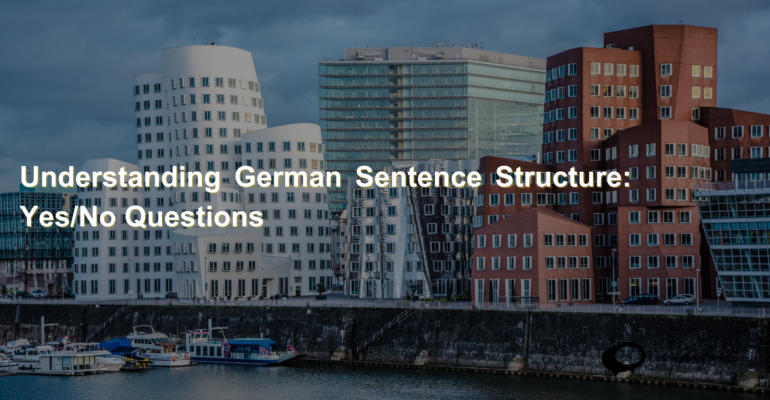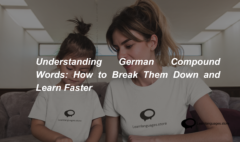Understanding German Sentence Structure: Yes/No Questions
Understanding German Sentence Structure: Yes/No Questions
Estimated reading time: 5 minutes
Welcome to the Learn Languages Store blog! In this post, we will explore an essential aspect of German grammar: Yes/No questions. These questions are fundamental for everyday conversations, allowing you to gather information and engage with others effectively. By mastering the structure of Yes/No questions in German, you’ll enhance your communication skills and confidence in speaking the language.

The Structure of Yes/No Questions in German
In German, Yes/No questions are typically formed by placing the verb at the beginning of the sentence, followed by the subject. This structure is different from English, where the subject often comes before the verb.
Basic Structure
- Verb + Subject + Object (if applicable)
For example:
Gehst du nach Hause?
(Are you going home?)
-
Product on sale
 German B1
German B1₹32,600.00
₹36,300.00 -
Product on sale
 German A2
German A2₹18,300.00
₹24,300.00
Conjugation of the Verb gehen (to go)
Before diving into examples, let’s look at how to conjugate the verb gehen in the present tense:
- ich gehe (I go)
- du gehst (you go – singular, informal)
- er/sie/es geht (he/she/it goes)
- wir gehen (we go)
- ihr geht (you go – plural, informal)
- sie/Sie gehen (they/you go – formal)
Example Sentences for Yes/No Questions
Here are five example sentences using Yes/No questions, along with word-to-word translations and pronunciation guides:
- Gehst du nach Hause?
(Are you going home?)
Pronunciation: गेस्ट डू नाच हौसे? - Hat er ein Buch?
(Does he have a book?)
Pronunciation: हाट एर आइने बुच? - Sind wir spät?
(Are we late?)
Pronunciation: जिंड वीर श्पेट? - Kommst du mit?
(Are you coming along?)
Pronunciation: कोम्स्ट डू मिट? - Ist das dein Hund?
(Is that your dog?)
Pronunciation: इस्ट दास डाइन हुन्ट?
Practical Uses of Yes/No Questions
- Gathering Information: Yes/No questions are often used to confirm information or gather details.
- Example: Hast du Zeit?
(Do you have time?)
Pronunciation: हास्ट डू ज़ाइट?
- Example: Hast du Zeit?
- Making Plans: You can use Yes/No questions to propose plans or check availability.
- Example: Geht ihr ins Kino?
(Are you going to the cinema?)
Pronunciation: गेइट इर इन्स काइनो?
- Example: Geht ihr ins Kino?
- Expressing Preferences: Use Yes/No questions to ask about preferences.
- Example: Möchtest du Kaffee?
(Would you like coffee?)
Pronunciation: मोक्टेस्ट डू काफे?
- Example: Möchtest du Kaffee?
- Checking Understanding: Use questions to ensure comprehension.
- Example: Verstehst du?
(Do you understand?)
Pronunciation: फेर्स्ट डू?
- Example: Verstehst du?
- Confirming Arrangements: Use Yes/No questions to confirm plans or details.
- Example: Sind wir morgen hier?
(Are we here tomorrow?)
Pronunciation: जिंड वीर मॉर्गन हीर?
- Example: Sind wir morgen hier?
Why Learning Yes/No Questions Matters
Understanding how to form Yes/No questions is crucial for effective communication in German. It allows you to engage in conversations, ask for clarification, and express your needs. Mastering this structure will significantly improve your conversational skills and confidence in speaking German.
Join Our Paid Courses for Enhanced Learning
At Learn Languages Store, we offer a comprehensive A1 level German course designed to help you master essential concepts like forming Yes/No questions and more! For just Rs 16,300/-, you will gain access to structured lessons, interactive exercises, and expert guidance that will transform your language skills.
Contact Us for More Information
If you’re interested in enrolling in our courses or have any questions, please reach out to us:
Learn Languages Store
330, 3rd Floor, Big Splash
(Near Vashi Bus Depot), Sector 17
Vashi, Navi Mumbai, Maharashtra 400703
Phone: +91-9594113111
Email: services@learnlanguages.store
Learning a new language is a rewarding experience that opens doors to new opportunities. Don’t miss the chance to enhance your skills with our expert-led courses!










